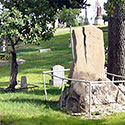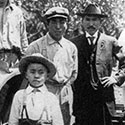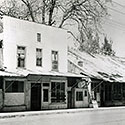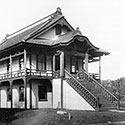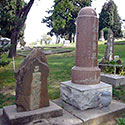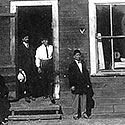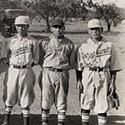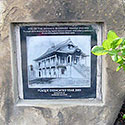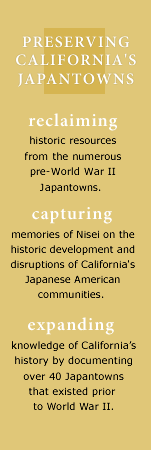 |
VacavilleConsidered the birthplace of Japanese contributions to California agriculture, Vacaville and the surrounding area were home to thousands of permanent residents and migrant Japanese laborers who worked in local orchards around the turn of the twentieth century. By 1906, a core business district had developed near Vacaville’s Chinatown to serve the needs of Japanese immigrants throughout the Vaca Valley. For several decades Vacaville served as the commercial, cultural and social hub for Japanese immigrants in Solano County, whose numbers climbed to several thousand during peak harvest season. Wartime relocation and patterns of hostility by white residents — 1500 locals signed a petition to prohibit post-war return of Nikkei — meant that Vacaville’s Japantown was not revived after World War II. A portion of the community cemetery and two small downtown markers are the only evidence of the Japanese community that once thrived here. ›› CLICK TO ENLARGE. PROFILES |
||||

The Vacaville-Elmira Cemetery contains the last historic resources associated with the city's once-vibrant Japantown. Beginning in the 1890s, local Nikkei buried their loved ones in a special "Japanese" section of this cemetery. Most of the dozens of headstones in the "Old Cemetery" section incorporate kanji characters, often on natural stone. A newer section holds rectangular headstones in English, several of which note the World War II military service of a Vacaville Nisei.

Two of the cemetery's markers hold special significance; the stone at left once marked the entrance to Vacaville's Buddhist Church on Dobbins Street. The columnar marker at right was erected in May 1957 in memory of Vacaville's Japantown and its residents; its inscription, E Ko Jo Sho, means "compassion, light of wisdom, always, shine." A tradition of Memorial Day gatherings at the cemetery has drawn former residents of Vacaville's Japantown since the 1950s. As the Nisei pass on, the number of attending has dramatically decreased.

Members of the Okabata, Takao and Matsuura families are depicted next to the first tractor bought by a Japanese farmer in the Vaca Valley around 1923. One of the first areas where Japanese immigrants engaged in farming, the region specialized in stone fruit crops, which ripened early due to the local climate and made Vaca Valley agriculture a profitable endeavor. By the 1890s Japanese work crews began to replace Chinese laborers in local orchards. Like Chinese immigrants, Japanese workers often made arrangements through an Issei labor contractor who spoke English and negotiated their job, wages and housing. After the turn of the century, Japanese farmers began leasing land and by 1912 controlled over 8000 acres through ownership, leases or sharecropping. Photo courtesy of the Vacaville Museum.

The Vacaville Steam laundry operated on Dobbins Street from 1913-1919. When the Miyashita family established their business, they joined a Japantown that included three pool halls, a barbershop, four boarding houses four confectionery stores, two restaurants, a bank, and four grocers who made part of their living from delivering orders to nearby labor camps. As Vacaville's Japanese American community grew and became more established it began to draw increasing negative attention from the burgeoning anti-Asian movement. Newspaper editorials and articles made reference to Vacaville as a prime example of the "Japanese Problem," and even compared it to a "suburb of Tokio." Photo courtesy of the Vacaville Museum.

Dobbins Street, which once held the local Chinatown, evolved during the first decade of the twentieth century into the commercial and cultural heart of Vacaville's Japanese American community. This photograph, taken around 1942, shows the Kimoto-Ya boarding house, Mishi's beauty salon, Nakamura's store, Ichimoto's Confectionery and pool hall, a barbershop, Oni-san's Tavern, ABC Co. market, Yamada's Confectionery, and a garage. Hairdresser Mishi Fujimoto Nojima remembered the pressure of preparing to leave Japantown in Spring of 1942 while serving her long-time clients; "everyone wanted to have their hair permanent waved." The Vacaville Museum displays her hairdressing equipment, along with a caption stating that Nojima worked in her shop until 2 AM the night before evacuation, and was accompanied by several of her clients to the train station when she left. Photo courtesy of the Vacaville Museum.

Japanese immigrants and their children enthusiastically adopted the sport of baseball, which dominated athletic activities in Vacaville. Takashi Tsuijita recalled that when the local Rough Riders team won a championship, Issei parents treated the boys to a "Chinameshi" dinner at Sam's Chinese Restaurant.
Vacaville's Nisei, like those in all of California's Japantowns, engaged in a range of activities that reflected their Japanese and American cultural roots. By 1940, the Japanese school established by the Buddhist Church had an enrollment of 80 students and employed three teachers whose charge was to transmit not only knowledge of reading and writing, but culture and customs from Japan. Clubs and activities centered on youth provided a variety of opportunities for entertainment, recreation and leadership. The 1930 and 1934 conferences of the Northern California Young Women's Buddhist Association drew dozens of Nisei women to Vacaville. The ground adjacent to the Buddhist Church was leveled for a playing field in the 1930s, and soon the Young Men's and Women's Buddhist Associations were known for their achievements in kendo, basketball, baseball and sumo events. Photo collection of California State University, Sacramento.

Several leaders of Vacaville's Japanese community traveled to San Francisco in 1908 to request that a Buddhist congregation, or sangha, be formed in Solano County. Within four years this grand structure was erected on Dobbins Street near Ulatis Creek. The two-story building was dedicated in November 1912, and cherry trees were planted facing the street. Its wide stairway led to a veranda with doors opening directly into the hondo, or worship space, which featured a shrine shipped from Japan. The upstairs also held the minister's office and residence, while the first floor house a large purpose room, kitchen, and two guest rooms. In later years a projection area for showing Japanese films was added under the stairs.
Illustrating the community's growing numbers of children, a Japanese language school was founded one month after the church's dedication, and a separate building was constructed behind the church in 1928. Vacaville's Japanese Association, whose headquarters stood directly across Dobbins Street from the Buddhist Church, supported the language school financially; at its peak the Association counted more than 500 members. Photo courtesy of the Vacaville Museum.

Vacaville's Buddhist Church held belongings for many local families during World War II, and like the Methodist Episcopal church, was vandalized in their absence. While Japantown residents were behind barbed wire, migrant workers from Mexico were permitted to live in the Buddhist Church during the peak time of harvest. The church and language school building served as a hostel for Nikkei who were unable to reclaim their homes upon their return in 1945.
A fire destroyed the church and surrounding buildings in 1951, and the sangha officially dissolved seven years later. In 2007, former resident Takashi Tsujita successfully nominated the Buddhist Church site as an official California Point of Historical Interest. This small marker in the corner of a parking lot at the former location of the Buddhist Church was dedicated in 2001. Along with a similar stone one half block away indicating "the former site of the Vacaville Asian business district," these memorials are all that recall Vacaville's historic Japantown.
